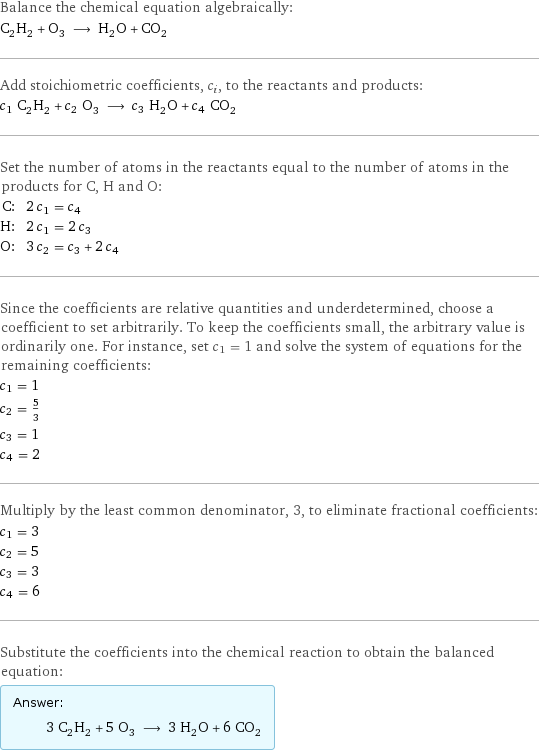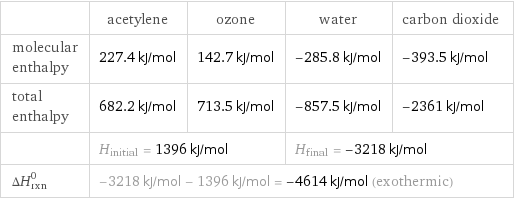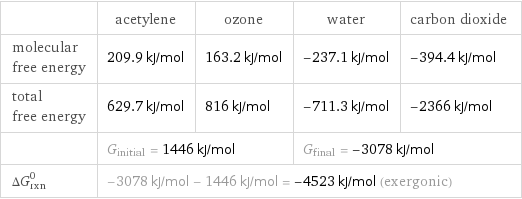Input interpretation

C_2H_2 acetylene + O_3 ozone ⟶ H_2O water + CO_2 carbon dioxide
Balanced equation

Balance the chemical equation algebraically: C_2H_2 + O_3 ⟶ H_2O + CO_2 Add stoichiometric coefficients, c_i, to the reactants and products: c_1 C_2H_2 + c_2 O_3 ⟶ c_3 H_2O + c_4 CO_2 Set the number of atoms in the reactants equal to the number of atoms in the products for C, H and O: C: | 2 c_1 = c_4 H: | 2 c_1 = 2 c_3 O: | 3 c_2 = c_3 + 2 c_4 Since the coefficients are relative quantities and underdetermined, choose a coefficient to set arbitrarily. To keep the coefficients small, the arbitrary value is ordinarily one. For instance, set c_1 = 1 and solve the system of equations for the remaining coefficients: c_1 = 1 c_2 = 5/3 c_3 = 1 c_4 = 2 Multiply by the least common denominator, 3, to eliminate fractional coefficients: c_1 = 3 c_2 = 5 c_3 = 3 c_4 = 6 Substitute the coefficients into the chemical reaction to obtain the balanced equation: Answer: | | 3 C_2H_2 + 5 O_3 ⟶ 3 H_2O + 6 CO_2
Structures

+ ⟶ +
Names

acetylene + ozone ⟶ water + carbon dioxide
Reaction thermodynamics
Enthalpy

| acetylene | ozone | water | carbon dioxide molecular enthalpy | 227.4 kJ/mol | 142.7 kJ/mol | -285.8 kJ/mol | -393.5 kJ/mol total enthalpy | 682.2 kJ/mol | 713.5 kJ/mol | -857.5 kJ/mol | -2361 kJ/mol | H_initial = 1396 kJ/mol | | H_final = -3218 kJ/mol | ΔH_rxn^0 | -3218 kJ/mol - 1396 kJ/mol = -4614 kJ/mol (exothermic) | | |
Gibbs free energy

| acetylene | ozone | water | carbon dioxide molecular free energy | 209.9 kJ/mol | 163.2 kJ/mol | -237.1 kJ/mol | -394.4 kJ/mol total free energy | 629.7 kJ/mol | 816 kJ/mol | -711.3 kJ/mol | -2366 kJ/mol | G_initial = 1446 kJ/mol | | G_final = -3078 kJ/mol | ΔG_rxn^0 | -3078 kJ/mol - 1446 kJ/mol = -4523 kJ/mol (exergonic) | | |
Entropy

| acetylene | ozone | water | carbon dioxide molecular entropy | 201 J/(mol K) | 239 J/(mol K) | 69.91 J/(mol K) | 214 J/(mol K) total entropy | 603 J/(mol K) | 1195 J/(mol K) | 209.7 J/(mol K) | 1284 J/(mol K) | S_initial = 1798 J/(mol K) | | S_final = 1494 J/(mol K) | ΔS_rxn^0 | 1494 J/(mol K) - 1798 J/(mol K) = -304.3 J/(mol K) (exoentropic) | | |
Equilibrium constant
![Construct the equilibrium constant, K, expression for: C_2H_2 + O_3 ⟶ H_2O + CO_2 Plan: • Balance the chemical equation. • Determine the stoichiometric numbers. • Assemble the activity expression for each chemical species. • Use the activity expressions to build the equilibrium constant expression. Write the balanced chemical equation: 3 C_2H_2 + 5 O_3 ⟶ 3 H_2O + 6 CO_2 Assign stoichiometric numbers, ν_i, using the stoichiometric coefficients, c_i, from the balanced chemical equation in the following manner: ν_i = -c_i for reactants and ν_i = c_i for products: chemical species | c_i | ν_i C_2H_2 | 3 | -3 O_3 | 5 | -5 H_2O | 3 | 3 CO_2 | 6 | 6 Assemble the activity expressions accounting for the state of matter and ν_i: chemical species | c_i | ν_i | activity expression C_2H_2 | 3 | -3 | ([C2H2])^(-3) O_3 | 5 | -5 | ([O3])^(-5) H_2O | 3 | 3 | ([H2O])^3 CO_2 | 6 | 6 | ([CO2])^6 The equilibrium constant symbol in the concentration basis is: K_c Mulitply the activity expressions to arrive at the K_c expression: Answer: | | K_c = ([C2H2])^(-3) ([O3])^(-5) ([H2O])^3 ([CO2])^6 = (([H2O])^3 ([CO2])^6)/(([C2H2])^3 ([O3])^5)](../image_source/2b5b03fd918a43609146d4fcea96afc3.png)
Construct the equilibrium constant, K, expression for: C_2H_2 + O_3 ⟶ H_2O + CO_2 Plan: • Balance the chemical equation. • Determine the stoichiometric numbers. • Assemble the activity expression for each chemical species. • Use the activity expressions to build the equilibrium constant expression. Write the balanced chemical equation: 3 C_2H_2 + 5 O_3 ⟶ 3 H_2O + 6 CO_2 Assign stoichiometric numbers, ν_i, using the stoichiometric coefficients, c_i, from the balanced chemical equation in the following manner: ν_i = -c_i for reactants and ν_i = c_i for products: chemical species | c_i | ν_i C_2H_2 | 3 | -3 O_3 | 5 | -5 H_2O | 3 | 3 CO_2 | 6 | 6 Assemble the activity expressions accounting for the state of matter and ν_i: chemical species | c_i | ν_i | activity expression C_2H_2 | 3 | -3 | ([C2H2])^(-3) O_3 | 5 | -5 | ([O3])^(-5) H_2O | 3 | 3 | ([H2O])^3 CO_2 | 6 | 6 | ([CO2])^6 The equilibrium constant symbol in the concentration basis is: K_c Mulitply the activity expressions to arrive at the K_c expression: Answer: | | K_c = ([C2H2])^(-3) ([O3])^(-5) ([H2O])^3 ([CO2])^6 = (([H2O])^3 ([CO2])^6)/(([C2H2])^3 ([O3])^5)
Rate of reaction
![Construct the rate of reaction expression for: C_2H_2 + O_3 ⟶ H_2O + CO_2 Plan: • Balance the chemical equation. • Determine the stoichiometric numbers. • Assemble the rate term for each chemical species. • Write the rate of reaction expression. Write the balanced chemical equation: 3 C_2H_2 + 5 O_3 ⟶ 3 H_2O + 6 CO_2 Assign stoichiometric numbers, ν_i, using the stoichiometric coefficients, c_i, from the balanced chemical equation in the following manner: ν_i = -c_i for reactants and ν_i = c_i for products: chemical species | c_i | ν_i C_2H_2 | 3 | -3 O_3 | 5 | -5 H_2O | 3 | 3 CO_2 | 6 | 6 The rate term for each chemical species, B_i, is 1/ν_i(Δ[B_i])/(Δt) where [B_i] is the amount concentration and t is time: chemical species | c_i | ν_i | rate term C_2H_2 | 3 | -3 | -1/3 (Δ[C2H2])/(Δt) O_3 | 5 | -5 | -1/5 (Δ[O3])/(Δt) H_2O | 3 | 3 | 1/3 (Δ[H2O])/(Δt) CO_2 | 6 | 6 | 1/6 (Δ[CO2])/(Δt) (for infinitesimal rate of change, replace Δ with d) Set the rate terms equal to each other to arrive at the rate expression: Answer: | | rate = -1/3 (Δ[C2H2])/(Δt) = -1/5 (Δ[O3])/(Δt) = 1/3 (Δ[H2O])/(Δt) = 1/6 (Δ[CO2])/(Δt) (assuming constant volume and no accumulation of intermediates or side products)](../image_source/8c9dfea5ac24f14c2106b982246e2be7.png)
Construct the rate of reaction expression for: C_2H_2 + O_3 ⟶ H_2O + CO_2 Plan: • Balance the chemical equation. • Determine the stoichiometric numbers. • Assemble the rate term for each chemical species. • Write the rate of reaction expression. Write the balanced chemical equation: 3 C_2H_2 + 5 O_3 ⟶ 3 H_2O + 6 CO_2 Assign stoichiometric numbers, ν_i, using the stoichiometric coefficients, c_i, from the balanced chemical equation in the following manner: ν_i = -c_i for reactants and ν_i = c_i for products: chemical species | c_i | ν_i C_2H_2 | 3 | -3 O_3 | 5 | -5 H_2O | 3 | 3 CO_2 | 6 | 6 The rate term for each chemical species, B_i, is 1/ν_i(Δ[B_i])/(Δt) where [B_i] is the amount concentration and t is time: chemical species | c_i | ν_i | rate term C_2H_2 | 3 | -3 | -1/3 (Δ[C2H2])/(Δt) O_3 | 5 | -5 | -1/5 (Δ[O3])/(Δt) H_2O | 3 | 3 | 1/3 (Δ[H2O])/(Δt) CO_2 | 6 | 6 | 1/6 (Δ[CO2])/(Δt) (for infinitesimal rate of change, replace Δ with d) Set the rate terms equal to each other to arrive at the rate expression: Answer: | | rate = -1/3 (Δ[C2H2])/(Δt) = -1/5 (Δ[O3])/(Δt) = 1/3 (Δ[H2O])/(Δt) = 1/6 (Δ[CO2])/(Δt) (assuming constant volume and no accumulation of intermediates or side products)
Chemical names and formulas

| acetylene | ozone | water | carbon dioxide formula | C_2H_2 | O_3 | H_2O | CO_2 name | acetylene | ozone | water | carbon dioxide
Substance properties

| acetylene | ozone | water | carbon dioxide molar mass | 26.038 g/mol | 47.997 g/mol | 18.015 g/mol | 44.009 g/mol phase | gas (at STP) | gas (at STP) | liquid (at STP) | gas (at STP) melting point | -81 °C | -192.2 °C | 0 °C | -56.56 °C (at triple point) boiling point | -75 °C | -111.9 °C | 99.9839 °C | -78.5 °C (at sublimation point) density | 0.618 g/cm^3 (at -55 °C) | 0.001962 g/cm^3 (at 25 °C) | 1 g/cm^3 | 0.00184212 g/cm^3 (at 20 °C) surface tension | 0.01431 N/m | | 0.0728 N/m | dynamic viscosity | | | 8.9×10^-4 Pa s (at 25 °C) | 1.491×10^-5 Pa s (at 25 °C) odor | | | odorless | odorless
Units
